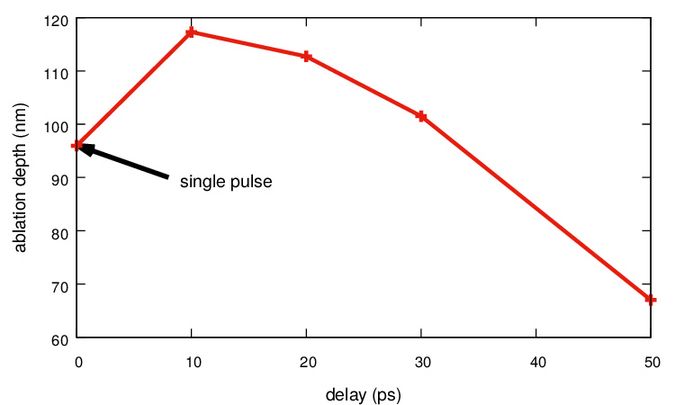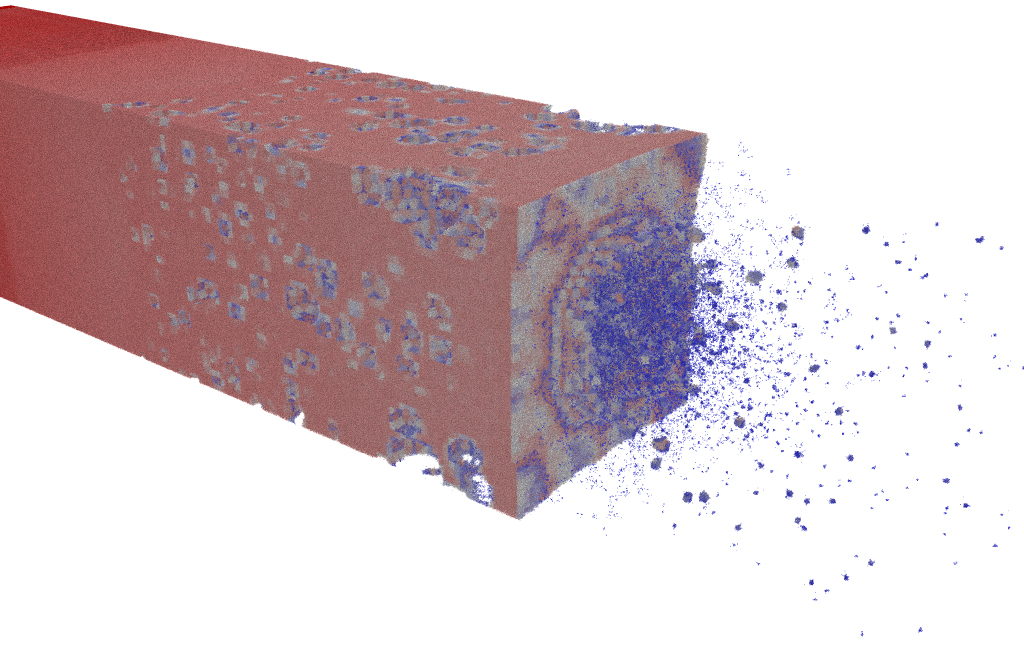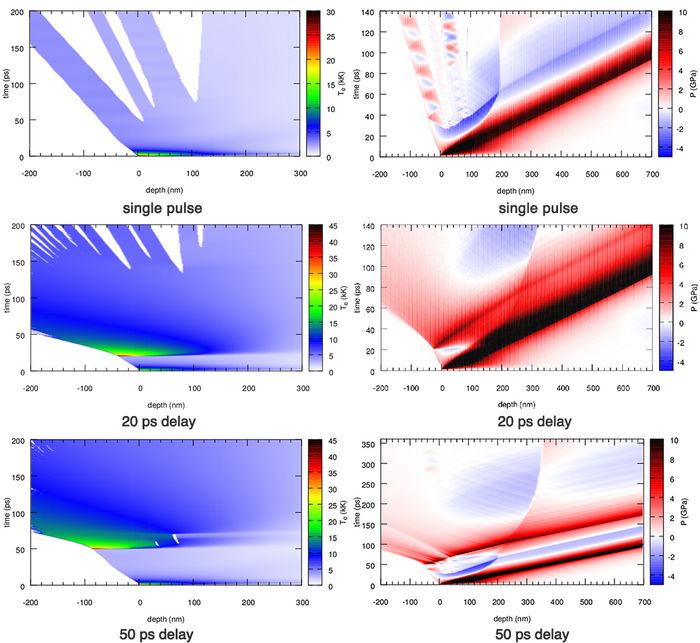MATERIALS SCIENCE AND CHEMISTRY
LASMD: Atomistic Simulations of Laser Ablation and Radiation Induced Ionization Effects
Principal Investigator:
Johannes Roth
Affiliation:
Institute for Theoretical and Applied Physics, University of Stuttgart (Germany)
Local Project ID:
LASMD
HPC Platform used:
Hazel Hen of HLRS
Date published:
Laser ablation is a technology which gains more an more importance in drilling, eroding, welding, structuring and marking of all kind of materials. The usage of shorter femtosecond laser pulses promises to improve the quality. Molecular dynamics simulations can contribute to new insights into the not completely comprehended ablation process with these short pulses. Researchers of the University of Stuttgart have developed a program package for the atomistic simulation of laser ablation which can deal with the coupling of the laser light, the heat conduction by the electrons, and the effects of a nascent plasma plume.
Only twenty years after the invention of the laser in the late 1950‘s, the smallest achievable pulse duration has shrunk by about six orders of magnitude and is currently at the fs-timescale (10-15 s), paving the way for new realms in research and application.
For instance, this short pulse duration allowed for measuring complex reaction dynamics in molecular systems by capturing the motion of electrons and atoms which was rewarded with the nobel prize for chemistry in 1999.
Apart from chemistry, the emergence of ultra short pulses has revolutionized micromachining of a wide range of materials to meet the requirements of ever smaller – and at the same time more efficient -- components for integrated circuits. Nowadays, typical applications include cutting, drilling, surface-structuring, deposition of thin films, laser surgery and many more.
The main advantage of ultra-short pulses over longer pulses is its ability to confine the deposited energy within a small localized volume of the irradiated target material without thermally or mechanically damaging the surrounding areas. Ideally, the target volume is directly evaporated without even melting (sublimation), leaving smooth, burr-free edges around the heat-affected zone.
In contrast, by using longer pulses, the material first melts, expands, introduces micro-cracks, and the ejected mixture of gas and liquid droplets may further deteriorate the surface structure.
In principle, the faster the boiling temperature is reached, the more efficient the evaporation and the less material is being melted. In particular, metals exhibit, in addition to the enhanced precision, an increasing ablation rate with decreasing pulse durations. However, depending on the actual material, this effect eventually approaches a saturation, and the ablation efficiency starts to drop below a minimum threshold duration.
Understanding the underlying physics and mutual influences of the various processes during laser-matter interaction can facilitate the optimization of experimental parameters in current applications as well as the development of novel laser technologies.
Due to the complex multiscale nature of interrelated processes triggered by laser irradiation including the energy absorption by electrons, the electron-phonon energy transfer, transitions to unusual metastable phases, generation of crystal defects, fracture/spallation, explosive boiling, as well as long-term evolution of the ablation plume (evaporation/condensation, chemical reactions, ionization), an experimental identification of the governing phenomena proves to be rather bothersome.
On the other hand, modelling and simulations make it possible to reduce the complexity and back-coupling effects to the essential ones, hence enable to systematically examine a specific issue by gradually bringing back the complexity until the origin of the effect under investigation is identified.
In this regard, classical Molecular Dynamics have proven to be a promising approach, as it provides a means to handle the highly non-equilibrium processes involved, without the necessity to make a priori assumptions on the mechanisms and kinetics that may take place during the simulation.
In order to include electronic effects, usually a two-temperature model is utilized where the electrons are described as a continuum, slowly transferring the absorbed energy to the atoms until an equilibrium is reached. The laser energy deposition is calculated by solving the Helmholtz wave equation using the Transfer Matrix Method known from multilayer optics. In addition, an ionization model gives access to the electron density and hence allows to model the dependence of thermal conductivity, specific heat, permittivity and electron-phonon coupling on temperature and density.
All these features and many more have been implemented into the Itap Molecular Dynamics Program (IMD) software package of the University of Stuttgart over the last year.
The main objective of this study is to find a way to include the effects of the interaction between the ablation plume, which may be partially ionized, with successive laser pulses since this may significantly influence the intensity arriving at the material surface.
As a first step, quasi-1 dimensional double pulse simulations of an aluminium single crystal target with varying pulse delays have been performed showing a reduced ablation efficiency with increasing pulse delays as is known from experimental observations. All pulses had a duration of 100 fs, a wave length of 800 nm and a fluence of 1 J/cm².

Figure 1: Ablation depths resulting from 100 fs-double pulse laser ablation simulations on aluminum with varying pulse delays compared to a single pulse.
Copyright: ITAP, Universität StuttgartFor pulse delays smaller than 50 ps the ablation depth is reduced since the tensile wave (rarefaction wave), which causes void formation and material fragmentation, is surpressed by the second pressure wave. This can be easily recognized from the pressure contour plots in Fig. 2 on the right hand side.
For delays bigger than 50 ps another mechanism becomes important: The majority of the second pulse is absorbed by the nascent plasma plume above the surface. Due to the reduced electron density within the plume, more light is absorbed leading to a more pronounced temperature elevation as depicted by the electron temperature contour plots in Fig. 2 on the left side.
However, the region where the light is absorbed is more extended as compared to shorter delays so that the associated energy is distributed over a larger volume leading to a lower intensity pressure wave. Correspondingly, the second rarefaction wave can only develop a rather low intensity, which is insufficient to cause severe fragmentation.
However, in experiments, three-dimensional effects such as surface waves, nonhomogeneous plume expansion, and thermo-capillary effects play an important role which are out of scope of the simulations so far.
Thanks to the HPC resources provided by the Cray XC40 system (Hazel Hen) at the HLRS, fully three-dimensional laser ablation simulations with billions of atoms at the micron length-scale become feasible. Recent simulations of a 200-million atom sample (see Fig. 3) with a size of 300x100x100 nm run on 4320 processors show promising scaling properties of the latest implementations into IMD and suggest that realistic simulations with laser spot diameters in the range of a few microns are currently only limited by the storage capacity available (about 5 TB per atomic configuration file). After all, this problem can be solved by a more economical file format.

Figure 3: Laser ablation of an aluminium single crystal consisting of 200 million atoms, 6 ps after a 100 fs laser pulse with a wave length of 800 nm. The colour coding represents density, showing the formation of large pores as well as the pressure wave and tensile wave on the surface.
Copyright: ITAP, Universität StuttgartDue to the computational limits of Molecular Dynamics, the full temporal evolution of the plasma plume (which may extend to some milliseconds) is out of scope. Fortunately, this task can be handled by the „Particle in Cell - Direct Simulation Monte Carlo“ (PIC-DSMC) simulation package by the SFB 716 subproject B8, where both the electrons‘ and the ions‘ motions are simulated by solving the Boltzmann transport equation.
Acknowledgements:
A big Thank You goes out to the HLRS for providing the computational resources and to the Deutsche Forschungsgemeinschaft for funding the Sonderforschungsbereich 716: “Dynamische Simulation von Systemen mit großen Teilchenzahlen“.
Project Team:
Eugen Eisfeld, Alexander Kiselev, Johannes Roth (PI)
References:
J. Roth, A. Kiselev, H. R. Trebin, Studying laser ablation with molecular dynamics simulations: from metals to covalent materials, 2016 Progress in Electromagnetic Research Symposium
A. Kiselev, J. Roth, H. R. Trebin, Molecular Dynamics Simulations of Silicon: The influence of Electron-Temperature dependent Interactions, High Performance Computing in Science and Engineering 2016
J. Roth, H. R. Trebin, A. Kiselev, D. M. Rapp, Laser Ablation of Al-Ni Alloys and Multilayers, Applied Physics A 122, 500 (2016)
D. Förster, S. Scharring, J. Roth, H. A. Eckel, Molecular Dynamics Simulations of Laser Induced Ablation for Micro Propulsion, High Performance Computing in Science and Engineering 2014
Scientific Contact:
Apl. Prof. Dr. rer. nat. Johannes Roth
Institute for Theoretical and Applied Physics, University of Stuttgart
Pfaffenwaldring 57, D-70550 Stuttgart
e-mail: johannes[at]itap.physik.uni-stuttgart.de
HLRS Project ID: LASMD
July 2017
